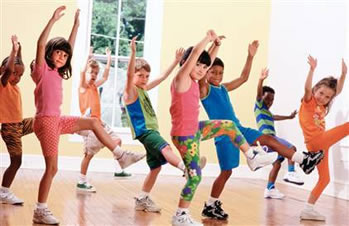
 Youth who regularly engage in physical activity and increase their heart rate have a better chance of living as healthy adults. Children and adolescents should participate in activities that are age-appropriate, enjoyable, and that offer a variety. There are three types of physical activity identified in the 2008 Physical Activity Guidelines for Americans (USDHHS: aerobic, muscle-strengthening and bone-strengthening. While each type has health benefits the importance of moderate- to vigorous-intensity aerobic activity will be discussed here
Youth who regularly engage in physical activity and increase their heart rate have a better chance of living as healthy adults. Children and adolescents should participate in activities that are age-appropriate, enjoyable, and that offer a variety. There are three types of physical activity identified in the 2008 Physical Activity Guidelines for Americans (USDHHS: aerobic, muscle-strengthening and bone-strengthening. While each type has health benefits the importance of moderate- to vigorous-intensity aerobic activity will be discussed here
Why are Moderate to Vigorous Intensity Aerobic Activities Important?
Aerobic activities are those in which young people rhythmically move their large muscles over an extended period of time. These are physical activities that require the heart and lungs to work harder to meet the body’s increased oxygen demand. Examples are running, swimming, dancing, and bicycling. Aerobic activities strengthen the heart and are especially important for cardiovascular fitness, but the benefits are not limited to heart health. According to the Mayo Clinic, regular aerobic activity can help in weight maintenance, immune system activation, and reducing symptoms of depression.
Aerobic Activity Guidelines for Children and Adolecents:
According to the 2008 Physical Activity Guidelines for Americans, children and adolescents should do 60 minutes (1 hour) or more of physical activity daily. Most of the 60 or more minutes should be either moderate or vigorous intensity aerobic physical activity, and should include vigorous intensity physical activity at least 3 days a week.

The Intensity Component of Aerobic Physical Activity:
According to the Centers for Disease Control and Prevention (CDC) a moderate-intensity activity is described as a 5 or 6 on a scale of 0 to 10, where sitting is a 0 and the highest level of activity is a 10. A vigorous-intensity activity is described as a 7 or 8.
Young people doing moderate-intensity activity will notice that their hearts are beating faster than normal and they are breathing harder than normal. When doing vigorous-intensity activity they will notice their heart beating much faster than normal and they will breathe much harder than normal.

Examples of Moderate-Intensity and Vigorous-Intensity Activities for Children and Adolecents:
It is important to note that some activities can be moderate or vigorous intensity depending on factors such as speed or the level of effort. A good example of this is bicycling.

The Other Components of Aerobic Physical Activity:
Frequency is how often a person does aerobic activity. Duration is how long a person does an activity in any one session. Combined with intensity all three components make up a physical activity profile. The CDC suggests that it appears that with youth, as with adults, that the total amount of physical activity is more important for achieving health benefits than is any one component (intensity, frequency, duration) individually.
![]()
United States Department of Health and Human Services
Physical Activity Guidelines for Americans - 2018
https://health.gov/sites/default/files/2019-09/Physical_Activity_Guidelines_2nd_edition.pdf














